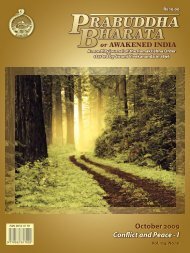According
August 2009 - Advaita Ashrama
August 2009 - Advaita Ashrama
- No tags were found...
Create successful ePaper yourself
Turn your PDF publications into a flip-book with our unique Google optimized e-Paper software.
PB August 2009<br />
The Spiritual and Cultural Ethos of Modern Hindi Literature 47<br />
A graceful portrayal of nature and an exquisite<br />
imagination are the striking features of Sumitranandan<br />
Pant’s works. He had his first lessons in<br />
nature appreciation and creative imagination in<br />
the Himalayan settings of his birthplace: Kausani<br />
in Almora. His study of Tilak’s Gita Rahasya, the<br />
Upanishads, Sri Ramakrishna Vachanamrit, and the<br />
works of Swamis Vivekananda and Ramtirth, made<br />
a deep impression on his young mind. He writes: ‘I<br />
received special inspiration from the books on neospirituality,<br />
that is, the works of Sri Ramakrishna,<br />
Ramtirth, and Vivekananda; and the life of Paramahamsaji<br />
[Ramakrishna] appeared to be mystery personified.’<br />
Pointing to Sri Ramakrishna’s leading role<br />
in the Indian renaissance, he observes: ‘The birth<br />
of Sri Ramakrishna symbolized the birth of a new<br />
India.’ It is reported that in 1935 he came in contact<br />
with Swami Chinmayananda of the Ramakrishna<br />
Kutir, Almora, who taught him how to overcome<br />
depression through meditation. In a poem he relives<br />
Swami Vivekananda’s visit to Almora. He successfully<br />
translated many of Swami Vivekananda’s<br />
poems, including ‘The Song of the Sannyasin’.<br />
In 1945, at a time when he was perplexed by<br />
Marxism, Gandhism, and such other doctrines, he<br />
happened to meet Sri Aurobindo. He first visited<br />
the Aurobindo Ashrama, along with the troupe of<br />
the famous dancer Uday Shankar, at the invitation<br />
of Ambalal Purani. Later, during his stay at Madras,<br />
he frequented the ashrama on a number of occasions.<br />
He obtained permanent solution to his personal<br />
as well as various social and cultural dilemmas<br />
in Sri Aurobindo’s philosophy. Having wended his<br />
way through Chhayavad mysticism and Marxism,<br />
he voiced a new cultural humanism under the influence<br />
of Sri Aurobindo’s philosophy. This humanism<br />
made possible the wonderful synthesis of human<br />
being and God, heaven and earth, the spiritual and<br />
the material, the nation and the world, society and<br />
the individual, body and soul.<br />
Following in the footsteps of Pant, Narendra<br />
Sharma too highlighted Sri Aurobindo’s philosophy<br />
in the poems he wrote after the songs of Lal Nishan<br />
(Red Insignia). His poems often speak of uniting<br />
bhu-raj, the dust of the earth, with suraj, the sun,<br />
which draws on Sri Aurobindo’s dream of raising<br />
the earth to heaven. Mahadevi Varma’s poems contain<br />
a deep strain of mysticism; but it is not so deep<br />
as to overshadow the soft strain of Buddha’s compassion.<br />
She created many poignant literary portraits<br />
of suffering women and laid the foundation of<br />
independent thought for women’s liberation.<br />
The works of nationalist poets like Makhanlal<br />
Chaturvedi and Balkrishna Sharma ‘Navin’ reveal<br />
a touch of spirituality and mysticism alongside intense<br />
feelings of patriotism and sacrifice, but the<br />
deep struggle with spiritual and cultural questions<br />
seen in Ramdhari Singh ‘Dinkar’ remains<br />
unmatched. Though he is known as a rebel poet<br />
with nationalistic leanings, the strains of his poetry<br />
reveal the tension between love and revolution, activity<br />
and renunciation, violence and non-violence,<br />
war and peace, Marx and Gandhi. His analysis of<br />
important historical questions on Indian culture in<br />
simple prose is incomparable. In Sanskriti ke Char<br />
Adhyay (Four Chapters of Culture)—an extremely<br />
interesting book, much like Jawaharlal Nehru’s<br />
Discovery of India—he explores India’s composite<br />
culture. The synthesis of Aryan and non-Aryan cultures,<br />
the rise of Buddhism, the harmony of Hinduism<br />
and Islam, and the Indian revival in reaction<br />
to British rule engage his deepest thoughts. He has<br />
great respect for Ramakrishna-Vivekananda, and<br />
his prose and poetry resounds with Swami Vivekananda’s<br />
message of practical Vedanta. He questions<br />
the one-sided growth of science and holds the synthesis<br />
of science and spirituality to be the best for<br />
humanity. Towards the end of his life he was influenced<br />
by the philosophy of Sri Aurobindo and<br />
wrote a book on him titled Chetana ki Shikha (The<br />
Flame of Awareness). He took the issue of harmony<br />
between Hinduism and Islam for the unity of the<br />
nation very seriously and stressed Swami Vivekananda’s<br />
concept of ‘Vedanta brain and Islam body’<br />
as a solution.<br />
Acharya Hazariprasad Dwivedi, another great<br />
Hindi literary critic, dwelt deeply on issues of culture<br />
and literature. He placed Kabir on the high seat<br />
487
















